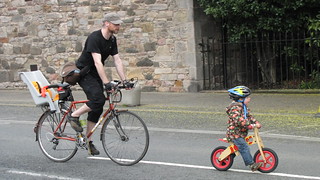ok, clear
The only issue is that if something like that AI summary is posted here, without the original executive summary for context, people will just look at the AI (as many do for Google searches now) and take that as Gospel
CityCyclingEdinburgh was launched on the 27th of October 2009 as "an experiment".
IT’S TRUE!
CCE is 16years old!
Well done to ALL posters
It soon became useful and entertaining. There are regular posters, people who add useful info occasionally and plenty more who drop by to watch. That's fine. If you want to add news/comments it's easy to register and become a member.
RULES No personal insults. No swearing.

ok, clear
The only issue is that if something like that AI summary is posted here, without the original executive summary for context, people will just look at the AI (as many do for Google searches now) and take that as Gospel
I know there is a huge push within the public sector to use AI to analyse consultation responses, as it is difficult to do well, requires highly trained staff, takes ages, costs a fortune and the end users (senior managers and elected members) typically have no idea of why any of this is the case and simply see it as a drain on resources - weirdly, not running a consultation is never seen as the solution to this.
Public sector managers, always suckers for tech hucksters that promise efficiency savings, are likely to start trialling this soon (public sector trials or pilots almost never see something being rejected as a bad idea as it reflects badly on whoever proposed it).
This could be bad for 'us' as AI analysis is more likely to treat consultations as referenda, rather than discerning between BS and valid/on topic responses.
For what it's worth, I believe that summarising text is one of the things AI is reasonable at in terms of lower hallucination count? However, ironically I might be hallucinating that I read that somewhere.
@bakky - I bow to your superior judgement on technical issues. However, my concern is that the analysis of consultation responses is simply seen as a summarising exercise, or analysing 'sentiment'.
The real human skill is understanding the context, going beyond analysing 'sentiment' to understanding whether the thinking behind that sentiment is based on a reasonable interpretation of fact.
I suspect AI would be quite good at coding responses and identifying hot topics, which can look very much like an actual analysis, without providing much in the way of true insight. This type of pseudo-analysis will probably be enough to convince most public sector managers mind.
You can get whatever kind of analysis you want out of it; if you prime it to be suspicious of NIMBY responses that might be using a legitimate sounding concern to block road space reallocation that's what it will give you. I don't think you could just ask it to analyse responses without providing any guidance on how to intepret them, or each model generation might give you different results.
For example when I asked chatGPT to assess a certain charity's consultation response on Spaces for People, it said:
It briefly acknowledges pandemic distancing aims and notes potential upsides like wider pavements and reduced clutter, but provides no discussion or evidence of the well-documented safety gains of protected cycleways for children/families (e.g., mode shift, collision reduction, independent travel).The core of the piece is a catalogue of accessibility risks (floating bus stops, loss of kerb access/Blue Badge bays, confusing temporary layouts, inaccessible consultations), survey stats highlighting disabled users’ difficulties, and a call to halt permanence without fuller Equality Impact Assessments and better consultation.
The only “benefits” retained are generic (wider pavements), with no attempt to balance them against child safety outcomes or to explore mitigations that reconcile both (e.g., accessible bus stop designs, tactile delineation, controlled crossings).
Bottom line: it’s a focused, one-sided critique aimed at ensuring accessibility and due process; it does not fairly weigh or even substantively acknowledge the dramatic safety benefits for children.
but if you ask it the same question with different framing, this is
"a vulnerable group whose independence and safety are compromised, and it makes a strong case that their needs have been overlooked in the rush to install active travel infrastructure."
So
AI will be useful when it realises it’s being asked leading questions?
Or not…
@Dave - thanks, that's fairly eye opening. Could something similar apply to the analysis and reporting on hundreds, or even thousands, of responses to a single consultation?
I can see future FOI requests looking for copies of the prompts that are used in these summaries.
Reviewed Jacobs report on Dean Bridge& referenced my experience with Roland Paxton/Ted Ruddock on historic roads & bridges in Scotland(including internal detail on Dean Bridge)
The official plans & report fail to consider the standard detail used on tram networks elsewhere (eg Croydon) where a constrained corridor uses interlaced single track with the regulation widely used for rail systems that run 2-ways on same track
Running single track across Dean Bridge could enable the work to take place without closing it to pedestrian & cycle traffic & Ted Ruddock's design upgraded Telfords Craigellachie cast iron bridge with cleverly concealed steel beams. The same appears to be a possible option for Dean Bridge anchoring a pre-loaded cable to the rock outcrop on the South side (with the rock depth on North Side lower down
Running trams under Queensferry Street (largely alluvial cover over the rock base (George Street looks to be mainly a raised beach, as is Princes Street)
Using the system proven in 1960's for construction of Oxford Circus Station, a large underground chamber at Lothian Road/Rutland Place can be constructed whilst traffic can still run overhead for a junction stop (moving existing one East to a better location for West End of Princes Street Historic ground survey logs from the planned railway line under Princes Street provide some basic detail for a city centre tram route that can remain open for major events with a huge list of other benefits as a transport interchange for trams, buses, coaches, & trains with all-weather public space running the length of Princes Street
“George Street looks to be mainly a raised beach, as is Princes Street“
I was under the impression that the past plan for underground car parks in GSt was abandoned because it was found to be rock(?)
Can we maybe put the cars underground (ideally sealed-in forever) and leave the trams on the surface instead?
You must log in to post.

 Cycling in Edinburgh Flickr group
Cycling in Edinburgh Flickr group
Video embedded using Easy Video Embed plugin